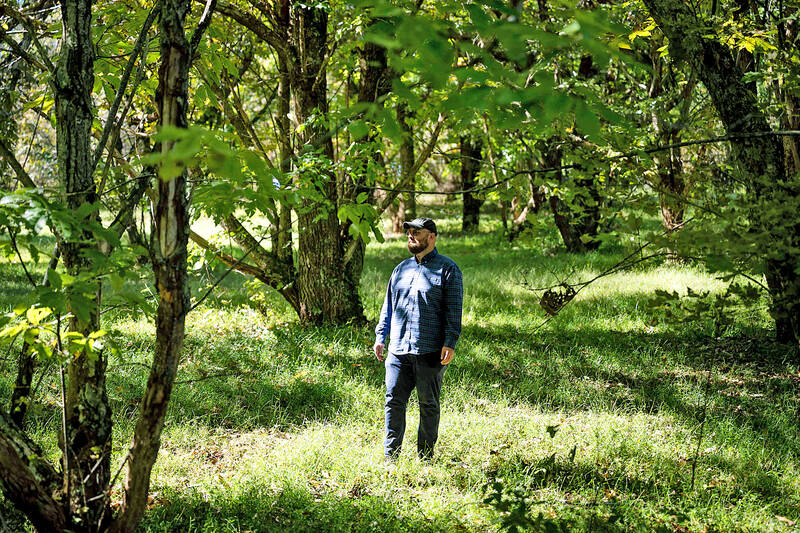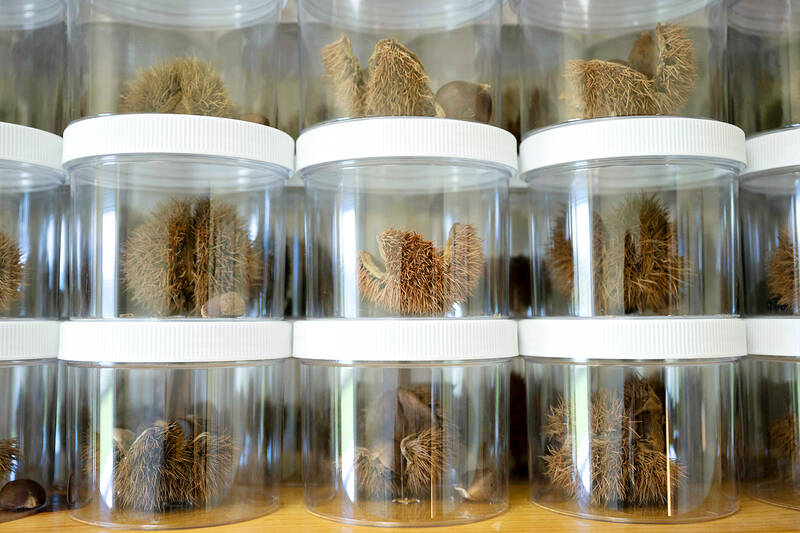The American chestnut tree, once a regal pillar of forests across the eastern US, is on life support, struggling to survive.
“These look like death,” said Vasiliy Lakoba, research director for the American Chestnut Foundation, which has been working since the 1980s to resurrect the species.
He pointed to a patch of stunted shrubs, chestnut trees that were a far cry from the noble, erect chestnut trees of yesteryear.

Photo: AFP
Settlers along the US eastern seaboard relied on abundant chestnut trees to feed their hogs, their children and themselves. Chestnuts made up about 50 percent of hardwood forests in much of the eastern seaboard, and the wood was ideal for building.
However, then came a terrible fungus, identified in 1904 at the Bronx Zoo on a tree from Japan. In less than three decades, millions of American chestnut trees had perished. It has been considered the greatest tragedy in the history of US forestry.
“The devastation was so fast,” said Lakoba, referring to “ghost forests.”

Photo: AFP
Today, only a few rare specimens still survive to adulthood in the wild.
Nestled in the Appalachian Mountains, the foundation’s main laboratory farm spans 36 hectares in Virginia and includes tens of thousands of trees.
Workers use a crane to harvest the burrs, or spiny prickly shells that cover the nuts, then take them to a shed to be studied and used for future planting.
“It’s like picking apples, but with pricks,” said Jim Tolton, a technician on the farm, during a chestnut harvest day early this month.
Before the disease, the American chestnut tree “grew tall and straight through the forest, fighting for light,” Lakoba said.
However, the blight causes cankers on the branches and stems of the trees.
Blighted trees grow other branches here and there, giving them a bushy appearance, instead of maintaining a tall, straight shape.
No cure has yet been found to stop the spread.
Finding a way to fight the blight is precisely the mission of the foundation. To do this, two main research avenues are under investigation:
The first, which has been in place for years, consists of crossing an American chestnut tree with other species that already show some resistance to the fungus, such as the Chinese chestnut tree. A first specimen is produced from this hybridization, before it is crossbred again with an American chestnut tree, then once again — all to preserve as much of the original genetic characteristics as possible.
The current hybrid has 15/16ths of the genetic makeup of an American chestnut tree, while ideally acquiring the resistance of the Chinese chestnut tree.
One of the main drawbacks with these hybrids “is that blight resistance and susceptibility have turned out to be a genetically much more complex phenomenon than previously thought,” Lakoba said.
Foundation researchers have not abandoned their crossbreeding efforts, but a second avenue of research has opened up: genetic modification.
Working on a transgenic version of the American chestnut tree, researchers at the State University of New York at Syracuse have developed a specimen that shows promising early results of disease resistance, said Lakoba, who is collaborating with the researchers.
Combining crossbreeding with genetic modification might yield better results, he said.
Once a resistant specimen has been developed, the time will come for the Herculean task of reintroducing the tree to a US landscape deeply altered by more than a century of development.
“So much has changed in terms of climate, in terms of invasive species, in terms of pollution, habitat change, land use change, soil loss and erosion, that it really isn’t the same world from 100 years ago,” Lakoba said.
Not only has the landscape been altered, climate change adds another wild card to whether the American chestnut can ever prosper again, he said.
“Overall, there will be more pests, there will be more diseases,” he said.
Any revival of the American chestnut might be decades — or centuries — away.
“This is definitely at least a couple centuries of a mission going forward. And from there, I think we just keep chipping away at it,” Lakoba said.
However, he is hopeful that scientific advances are on the side of the American chestnut.
“We see it really as a matter of time,” he said.

Australia has announced an agreement with the tiny Pacific nation Nauru enabling it to send hundreds of immigrants to the barren island. The deal affects more than 220 immigrants in Australia, including some convicted of serious crimes. Australian Minister of Home Affairs Tony Burke signed the memorandum of understanding on a visit to Nauru, the government said in a statement on Friday. “It contains undertakings for the proper treatment and long-term residence of people who have no legal right to stay in Australia, to be received in Nauru,” it said. “Australia will provide funding to underpin this arrangement and support Nauru’s long-term economic

‘NEO-NAZIS’: A minister described the rally as ‘spreading hate’ and ‘dividing our communities,’ adding that it had been organized and promoted by far-right groups Thousands of Australians joined anti-immigration rallies across the country yesterday that the center-left government condemned, saying they sought to spread hate and were linked to neo-Nazis. “March for Australia” rallies against immigration were held in Sydney, and other state capitals and regional centers, according to the group’s Web site. “Mass migration has torn at the bonds that held our communities together,” the Web site said. The group posted on X on Saturday that the rallies aimed to do “what the mainstream politicians never have the courage to do: demand an end to mass immigration.” The group also said it was concerned about culture,

ANGER: Unrest worsened after a taxi driver was killed by a police vehicle on Thursday, as protesters set alight government buildings across the nation Protests worsened overnight across major cities of Indonesia, far beyond the capital, Jakarta, as demonstrators defied Indonesian President Prabowo Subianto’s call for calm. The most serious unrest was seen in the eastern city of Makassar, while protests also unfolded in Bandung, Surabaya, Solo and Yogyakarta. By yesterday morning, crowds had dispersed in Jakarta. Troops patrolled the streets with tactical vehicles and helped civilians clear trash, although smoke was still rising in various protest sites. Three people died and five were injured in Makassar when protesters set fire to the regional parliament building during a plenary session on Friday evening, according to

STILL AFLOAT: Satellite images show that a Chinese ship damaged in a collision earlier this month was under repair on Hainan, but Beijing has not commented on the incident Australia, Canada and the Philippines on Wednesday deployed three warships and aircraft for drills against simulated aerial threats off a disputed South China Sea shoal where Chinese forces have used risky maneuvers to try to drive away Manila’s aircraft and ships. The Philippine military said the naval drills east of Scarborough Shoal (Huangyan Island, 黃岩島) were concluded safely, and it did not mention any encounter with China’s coast guard, navy or suspected militia ships, which have been closely guarding the uninhabited fishing atoll off northwestern Philippines for years. Chinese officials did not immediately issue any comment on the naval drills, but they